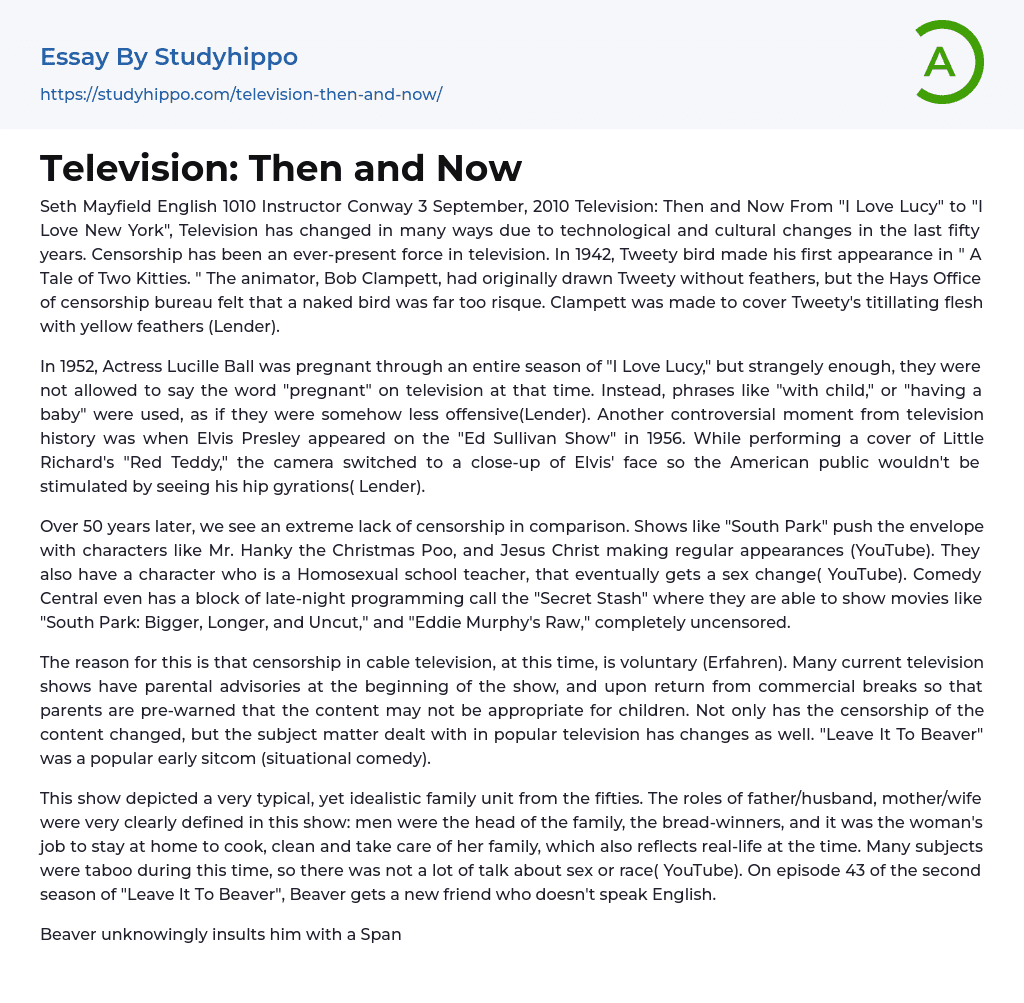From "I Love Lucy" to "I Love New York", Television has changed in many ways due to technological and cultural changes in the last fifty years. Censorship has been an ever-present force in television. In 1942, Tweety bird made his first appearance in " A Tale of Two Kitties. " The animator, Bob Clampett, had originally drawn Tweety without feathers, but the Hays Office of censorship bureau felt that a naked bird was far too risque. Clampett was made to cover Tweety's titillating flesh with yellow feathers (Lender).
In 1952, Actress Lucille Ball was pregnant through an entire season of "I Love Lucy," but strangely enough, they were not allowed to say the word "pregnant" on television at that time. Instead, phrases like "with child," or "having a baby" were used, as if they were somehow less offensive(Lender). Another controversi
...al moment from television history was when Elvis Presley appeared on the "Ed Sullivan Show" in 1956. While performing a cover of Little Richard's "Red Teddy," the camera switched to a close-up of Elvis' face so the American public wouldn't be stimulated by seeing his hip gyrations( Lender).
Over 50 years later, we see an extreme lack of censorship in comparison. Shows like "South Park" push the envelope with characters like Mr. Hanky the Christmas Poo, and Jesus Christ making regular appearances (YouTube). They also have a character who is a Homosexual school teacher, that eventually gets a sex change( YouTube). Comedy Central even has a block of late-night programming call the "Secret Stash" where they are able to show movies like "South Park: Bigger, Longer, and Uncut," and "Eddie Murphy's Raw," completely uncensored.
Th
reason for this is that censorship in cable television, at this time, is voluntary (Erfahren). Many current television shows have parental advisories at the beginning of the show, and upon return from commercial breaks so that parents are pre-warned that the content may not be appropriate for children. Not only has the censorship of the content changed, but the subject matter dealt with in popular television has changes as well. "Leave It To Beaver" was a popular early sitcom (situational comedy).
This show depicted a very typical, yet idealistic family unit from the fifties. The roles of father/husband, mother/wife were very clearly defined in this show: men were the head of the family, the bread-winners, and it was the woman's job to stay at home to cook, clean and take care of her family, which also reflects real-life at the time. Many subjects were taboo during this time, so there was not a lot of talk about sex or race( YouTube). On episode 43 of the second season of "Leave It To Beaver", Beaver gets a new friend who doesn't speak English.
Beaver unknowingly insults him with a Spanish phrase Eddie taught him. The awkwardness of the language barrier and the message of acceptance is predominant in this episode, was a pretty touchy subject for the era. In contrast, a popular sitcom today is "Two and a Half Men". In this show, a young boy lives in a home with his father and womanizing uncle (YouTube). The construct of the traditional atomic family is thrown out the window for this show. On one episode, the boy, Jake, asks his father and uncle about erectile dysfunction
and use the word penis openly.
Another episode deals with an ex-teacher of Jakes having to take a job as a stripper. On this episode, Charlie and Alan actually go to the bikini club, and Alan gets a lap dance, all on primetime network television (YouTube). The Content and subject matter of these episodes would likely have caused a civil war back in the fifties. Another difference is the genre of popular programs . Variety shows and sitcoms such as "The Ed Sullivan Show" and "I Love Lucy" were very popular in the early days of television. In the last decade or so, we have seen a large shift toward reality shows.
A reality show simply captures people reacting and behaving to any situation as they would naturally when a script isn't provided(Reality TV). Debuting in 1989, "Cops" is one of the earliest and most popular reality television shows, which follows law enforcement officers of a chosen city as they chase down suspects (Reality TV). Another large difference in television today, is the way we watch. Not long ago we only had one way to watch television: tune our sets to the station we wanted to watch at the time the show we wanted to watch aired.




